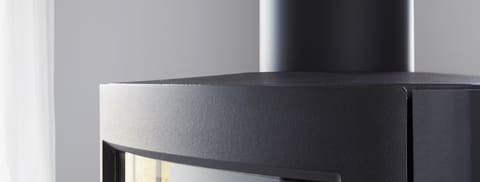Good things to know about chimneys

A good chimney is required if your wood-burning stove is to have optimum combustion.
The most important task of a chimney is drawing draught to ensure optimum combustion in the stove and the ability to draw smoke out through the chimney.
Best results are achieved if there is a large difference in temperature between the air in the chimney and the air outside and if the chimney has the right height and dimensions relative to the stove.
As long as the chimney draws a good draught, either a masonry or steel chimney can be used when installing a wood-burning stove. When using a masonry chimney, it is important that the correct flue pipe inlet is used when installing the wood-burning stove. An insulated core lining is recommended for masonry chimneys, usually known as isokern
Modern wood-burning stoves are more demanding
Modern wood-burning stoves are more demanding of chimneys than older models. Modern stoves burn cleaner and have higher combustion efficiency. The higher combustion efficiency means more heat in your room for the same amount of firewood. This also means that less energy is required to heat up your chimney.
When replacing an old wood-burning stove with a modern one that has higher combustion efficiency, you may experience that your chimney no longer has optimal draw. This is typically seen on masonry chimneys that have no insulated core. A good solution to this issue would be to fit a smoke extractor to your chimney.
If your chimney is borderline in its draw, you may also experience that ash and smoke is blown into the room when the stove door is opened. A smoke extractor would also be of benefit here.
Which chimney works best?
A masonry chimney will take longer to heat up than an insulated steel chimney before it can achieve optimum combustion, as steel heats up a lot faster than brickwork.
The best results are achieved with well-insulated chimneys that are about 4 metres or more from the flue inlet to the top of the chimney
The chimney’s draw will depend on the size of the stove.
What compromises a chimney?
- Old/leaky chimney (cracks in the chimney pipe or masonry)
- Badly-insulated chimney (older steel pipes)
- Low chimney height (less than 4 metres) from flue pipe inlet to top of chimney.
- Non-airtight cleaning hatches causing the chimney to draw the wrong air
- Leaks – open draw valves to other stoves that are not in use.
- Limited or no access to fresh air in the room where the stove is installed.
- Extractor hoods
- Adjusted ventilation (supplier has failed to consider wood-burning stoves)
- Low-energy houses or renovated houses with newer, more airtight windows where a sufficient flow of fresh air has not been considered.
Remember to agree with your chimney sweeper whether your chimney requires stepping. All new chimneys must be approved by a chimney sweeper.
